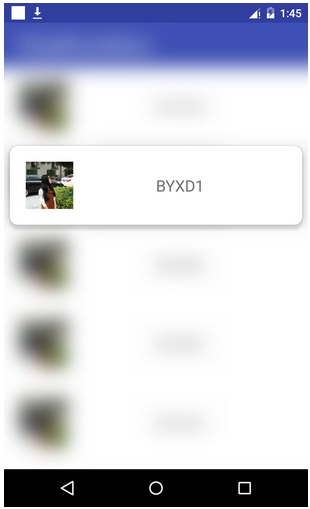編輯:關於Android編程
本文實例講述了Android實現調用震動的方法。分享給大家供大家參考,具體如下:
調用Android系統的震動,只需要一個類 那就是Vibrator ,這個類在hard包中,一看系統級的服務,又要通過manifest.xml文件設置權限了
<?xml version="1.0" encoding="utf-8"?>
<manifest xmlns:android="http://schemas.android.com/apk/res/android"
package="uni.vibrator"
android:versionCode="1"
android:versionName="1.0">
<uses-sdk android:minSdkVersion="8" />
<application android:icon="@drawable/icon" android:label="@string/app_name">
<activity android:name=".VibratorDemoActivity"
android:label="@string/app_name">
<intent-filter>
<action android:name="android.intent.action.MAIN" />
<category android:name="android.intent.category.LAUNCHER" />
</intent-filter>
</activity>
</application>
<uses-permission android:name="android.permission.VIBRATE" />
</manifest>
下面還是一起學習一下SDK吧
Class that operates the vibrator on the device.
If your process exits, any vibration you started with will stop.
//Vibrator類用來操作設備上的震動,如果你的線程退出了,那麼啟動的震動也會停止
public void vibrate (long[] pattern, int repeat)
Since: API Level 1
Vibrate with a given pattern. //根據給定的節奏震動
Pass in an array of ints that are the durations for which to turn on or off the vibrator in milliseconds. The first value indicates the number of milliseconds to wait before turning the vibrator on. The next value indicates the number of milliseconds for which to keep the vibrator on before turning it off. Subsequent values alternate between durations in milliseconds to turn the vibrator off or to turn the vibrator on.
//傳遞一個整型數組作為關閉和開啟震動的持續時間,以毫秒為單位。第一個值表示等待震動開啟的毫秒數,下一個值表示保持震動的毫秒數,這個序列值交替表示震動關閉和開啟的毫秒數
To cause the pattern to repeat, pass the index into the pattern array at which to start the repeat, or -1 to disable repeating.
//為了重復的按設定的節奏震動,傳遞index參數表示重復次數,用-1表示不重復。
Parameters
pattern an array of longs of times for which to turn the vibrator on or off.
repeat the index into pattern at which to repeat, or -1 if you don't want to repeat.
還包含一個方法叫做cancel,用來取消震動
看一段演示的代碼:
/*
* @author octobershiner
* SE.HIT
* 一個使用android手機震動的demo
* */
package uni.vibrator;
import android.app.Activity;
import android.content.Context;
import android.os.Bundle;
import android.os.Vibrator;
public class VibratorDemoActivity extends Activity {
private Vibrator vibrator;
/** Called when the activity is first created. */
@Override
public void onCreate(Bundle savedInstanceState) {
super.onCreate(savedInstanceState);
setContentView(R.layout.main);
/*
* 想設置震動大小可以通過改變pattern來設定,如果開啟時間太短,震動效果可能感覺不到
* */
vibrator = (Vibrator)getSystemService(Context.VIBRATOR_SERVICE);
long [] pattern = {100,400,100,400}; // 停止 開啟 停止 開啟
vibrator.vibrate(pattern,2); //重復兩次上面的pattern 如果只想震動一次,index設為-1
}
public void onStop(){
super.onStop();
vibrator.cancel();
}
}
希望本文所述對大家Android程序設計有所幫助。
 Android顯式意圖、隱式意圖、意圖過濾器(intent-filter)、意圖間傳值
Android顯式意圖、隱式意圖、意圖過濾器(intent-filter)、意圖間傳值
intent主要包括隱式意圖和顯式意圖。顯式意圖通常主要是啟動本應用中的Activity之間的數據,而隱式意圖則常見於啟動系統中的某些特定的動作,比如打電話,發短信,或者
 安卓(Android)實現3DTouch效果
安卓(Android)實現3DTouch效果
本篇博客要做的效果圖:來個低質量動圖:這個動圖效果不是很好,實際上模糊效果應該是像上面第一張圖那樣的,後面會放出代碼,有興趣的可以試著運行一下看看效果。 先說一
 Android實現下拉菜單Spinner效果
Android實現下拉菜單Spinner效果
Android 中下拉菜單,即如html中的<select>,關鍵在於調用setDropDownViewResource方法,以XML的方式定義下拉菜單要顯示
 一個android群組通知APP的數據框架
一個android群組通知APP的數據框架
項目地址:https://github.com/wlkdb/GA_network_info點擊打開鏈接1、整個app分為android客戶端、java服務端和數據層,客戶